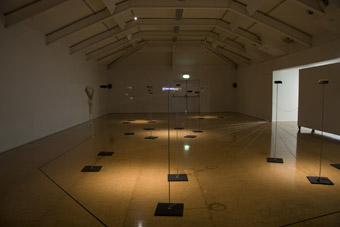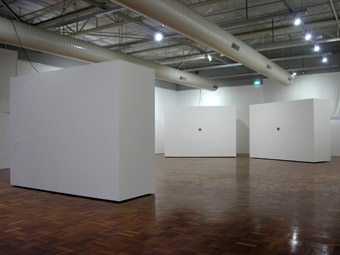threshold intimacies
mitchell whitelaw: collars; liminal transitions; canberra

Collars, Alexandra Gillespie & Somaya Langley
photo courtesy of the artists
Collars, Alexandra Gillespie & Somaya Langley
BILL BRYSON ONCE DESCRIBED CANBERRA AS “A CITY HIDING IN A PARK”; A PITHY EXPRESSION OF THE QUIET, DISPERSED FEEL OF OUR NATION’S CAPITAL. IT’S NOT AN ABSENCE, THOUGH; LIKE BRYSON SAYS, IT’S A SENSE OF CONCEALMENT, OF UNSEEN LAYERS.
The Collars of Alexandra Gillespie and Somaya Langley’s installation stand in clusters in dimmed exhibition space. Each collar is a found object, collected from the artists’ friends and families, then detached and installed at the height of each owner; so as we enter the exhibition space we sense a crowd of absent bodies, grouped into little social clusters. Framed this way, the power of the collar to confer and express identity is inescapable; these swatches of fabric expand in our imagination into whole characters. Another layer: inside each collar, a single electroluminescent word glows, on and off; the word is keyed into spoken text, from the collar’s owner, dispersed in an immersive soundtrack.
The work is beautifully poised between intimacy and abstraction; between warm, sociable glimpses of the collars’ owners, and the formal control of the minimal stands, the cool glow of the texts. The sound field and the hovering collars give the work a heightened sense of spatial depth and interrelation; a network aesethetic, but one that is also absolutely material, made of wire and fabric, punctuated by the solenoid clicks of the switching circuits. As our personal interactions become increasingly abstracted and digitally compressed, we need more social machines like this, sourced from right next to our skin, evoking layers of our experience that don’t fit into a status update.
As its title suggests, Chris Fortescue’s LiminalTransitions dwells in a similarly poised threshhold space: between randomness and order, information and noise, foreground and background, intention and accident. In the Naturalism08 series Fortescue scans scraps of newsprint and packaging, then passes the source material through a set of geometric rotations and reflections. Structure inevitably emerges from these abject, crumpled things; what started as meaningless form acquires a sense of organic integrity. The results are visually seductive but suggest an ambivalence about form, structure, even beauty; if it is just junk with a dash of symmetry, where does this leave us?
Fortescue channels Duchamp in several works here; his Rectified Searches are low-fi digital images sourced from web searches for “Road”, “Fog”, and “Chris.” Duchamp’s “rectified” works are found objects subjected to a slight intervention or manipulation—L.H.O.O.Q, a cheap print of the Mona Lisa with a pencilled-on moustache, is the best-known example. Fortescue digitally rectifies his modern readymades—extrusions from the networked collective consciousness—decimating the face of each Chris into a pixel grid, slicing and transposing discs from the Roads. These minimal interventions throw the found images off balance, leaving the viewer suspended in their sense of hybrid, decentered agency.

Liminal Transitions, Chris Fortescue
photo courtesy of the artist
Liminal Transitions, Chris Fortescue
Fortescue’s Resettings is his most successful manifestation of this networked or distributed authorship. Here he works with, and between, Michael Heiser’s land art work Double Negative, and Polish artist Edward Krasinsky, whose installations and exhibitions were often bisected by a horizontal line marked in bright blue tape. In Resettings Fortescue has wrapped rocks from the site of Double Negative in metres and metres of Krasinsky-blue tape. The resulting objects are intense sculptural forms in themselves: taut, shiny little capsules of…what? In the accompanying essay the artist teases out the network of resonances, coincidences and nodal events that unfold from the work; it becomes an expansive meditation on the mingled, tangled causalities of being in the world, against the simple-minded fiction of intention.
airConResonator literally hovers over the ANU School of Art exhibition space: it appropriates the air conditioning ducts that span the ceiling, miking them up and feeding their background noise through a filter, then piping it back into the room. Visually the work is barely there: two white walls—in fact giant resonators—each with a single, shiny speaker cone embedded. Even sonically the amplified air con is a diaphonous pillow of sensation, apparent only on close listening. The work tunes us in to the edges of aural perception, pushing the background forward just enough so that, suddenly, we hear it everywhere. Like the crumpled chip packets in the Naturalism prints, air con noise is waste, chaos; but acoustically, noise contains everything, all frequencies, all possibilities, all structure. And the ducts are physical resonators that double as readymade metaphor; a networked distribution system but also, as in Terry Gilliam’s Brazil, a secret, hidden world, where everything is connected. Very Canberra, really.
Alexandra Gillespie and Somaya Langley, Collars, Canberra Contemporary Art Space, March 26-May 2; Chris Fortescue, Liminal Transitions, ANU School of Art Gallery, Canberra, Jan 28-Feb 6
RealTime issue #91 June-July 2009 pg. 30






